Defining ideal sow body condition
October 15, 2013
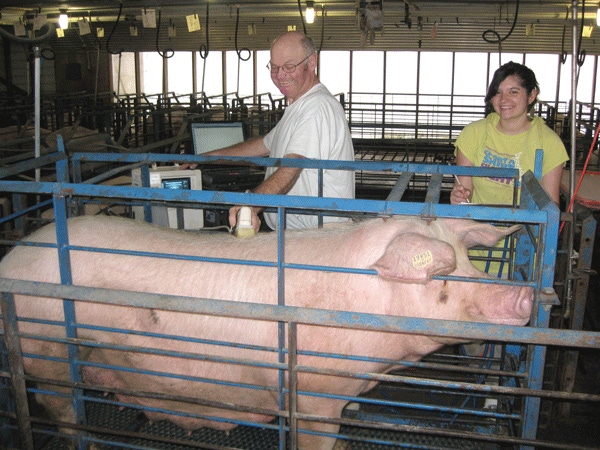
Maintaining optimal sow body condition is an important strategy to maximize animal well-being and sow lifetime productivity. Most commercial producers feed gestating sows based on a visual (subjective) measure of body condition. However, the majority of barn workers, farm managers and service people are not highly trained in estimating body composition.
Further compounding problems with visual sow body condition scoring is the fact that the perceived ideal target for sow body condition varies among individuals.
Recently, North Carolina State University research validated sizable variation in sow body condition between farms within the same production system using the same genetics, diets and housing. The only difference between farms was the people adjusting the feed-drop boxes. These results suggest fast and accurate sow body condition tools would allow for needed standardization across farms.
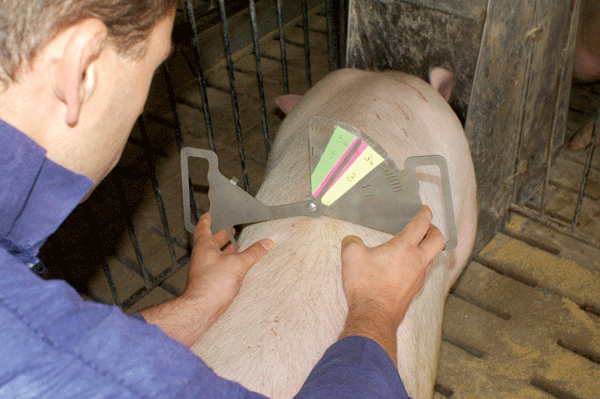
The sow body condition caliper can be used to assess sows and aid feeding decisions.
Sow body condition is a composite trait of weight, backfat and muscling. This statement is supported by research results from several studies. In the past, many researchers and producers have used backfat as an objective measure of sow body condition. Backfat measurements can be a decent indicator of body condition. However, backfat is a poor indicator of muscling, an important component trait of body condition. Perhaps objective measurements of sow body condition should account for both backfat and muscling.
Surprisingly few studies have tried to identify the optimal sow body condition in relation to subsequent reproductive performance. Past research indicates a threshold level of body reserves is needed for reproduction. If sows lose greater than 16% of their muscle mass during lactation, subsequent reproductive performance declines. However, on today’s commercial farms, determining loss of muscle mass during lactation may not be cost-effective.
Keep the most in-depth pork production information available at your fingertips! Download our Blueprint app today.
There is some speculation that a one-time measure of sow body condition would be more practical. Yet the body condition threshold at which sow reproductive performance deteriorates is not well-defined.
Therefore, the objective of the current study was to identify optimal sow body condition in relation to subsequent reproductive performance.
Data were collected from a 4,000-sow commercial farm in eastern North Carolina between August 2012 and May 2013. Sow parity ranged from 2 to 11. Sows were weaned into individual stalls, where they had ad-libitum access to water, and were limit-fed according to body condition. Sows were mixed at day 35 of pregnancy, based on weight and body condition, into group pens containing four or five sows.
Sow body condition measurements were taken both at breeding and again one week prior to farrowing by NCSU research technicians. Due to labor constraints, more sows were measured at breeding than at farrowing. Body condition traits included weight, backfat and loin eye area as measured from a 10th rib, cross-sectional image by a real-time ultrasound technician. Additional measurements were taken using the sow body condition caliper; visual body condition was scored on a 1 (thin) to 5 (fat) scale. Descriptive statistics for body condition traits are presented in Table 1 below.
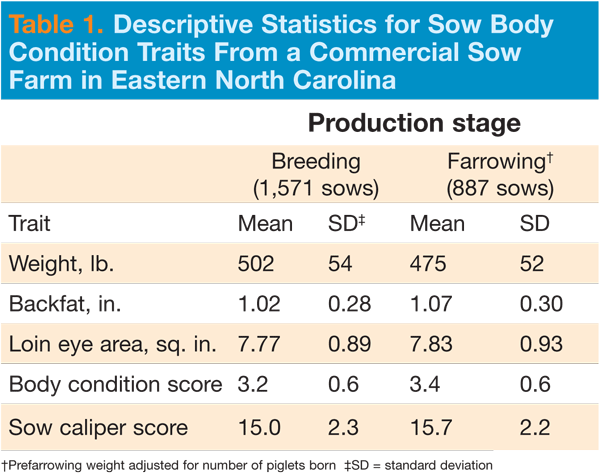
Sows were also scored for shoulder lesions, vulva lesions, feet lesions and locomotion. In lactation, sow feed intake, total number born, number born alive, litter birth weight, number weaned and litter weaning weight were recorded by farm staff. After lactation, wean-to-conception interval was recorded for the subsequent litter. Barn, group and parity were included as fixed effects in all statistical models.
Sow Condition at Breeding, Subsequent Performance
Of the 1,571 sows that were measured at breeding, 1,349 (86%) farrowed a litter. Sows that farrowed a litter had greater caliper scores (15.0 vs. 14.7) and greater backfat (1.03 vs. 0.97 in.) in comparison to sows that did not farrow.
Although these differences were statistically different, caliper scores and backfat explained little about the variation in farrowing rate. Perhaps this was because the majority of the sow herd was in optimal body condition (caliper score 12 to 15, 52%) or overconditioned (caliper score ≥16, 41%) at breeding. Conducting the same experiment in a herd with less condition may produce different results. One can hypothesize that sow body condition would have a greater association with farrowing rate in a herd with thinner sows.
Litter birth traits had significant associations with breeding: weight, backfat, body condition score and sow caliper score. Weight at breeding had a curvilinear relationship with number born alive (See Figure 1).
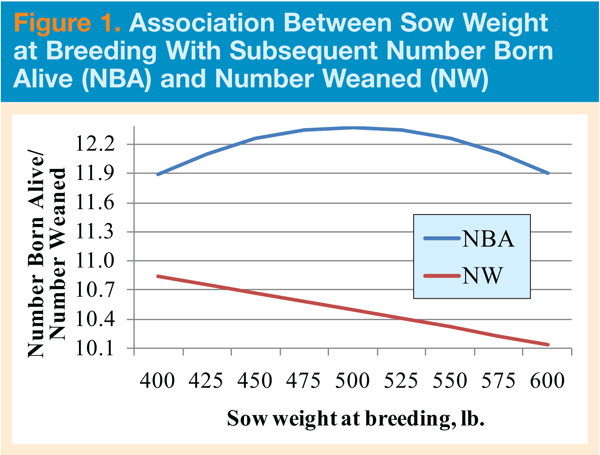
The optimal sow weight in relation to number born alive was 500 lb. Sows that were substantially lighter or heavier than 500 lb. had a smaller litter size. Lower backfat depth at breeding had a linear association with number born alive and litter birth weight. For each 0.1-in. decrease in backfat, number born alive and litter birth weight increased by 0.07 piglets and 0.26 lb., respectively.
Sow body condition score at breeding had a curvilinear relationship with both number born alive and litter birth weight. The optimal body condition in relation to number born alive and litter birth weight was a score of 3.25. Sows that were substantially thinner or fatter than a condition score of 3.25 had a smaller litter size.
Similar to body condition, the sow caliper measurement had curvilinear relationships with both number born alive and litter birth weight (See Figure 2). The optimal sow caliper score in relation to number born alive was 15, and litter birth weight was optimized with a caliper score of 14.
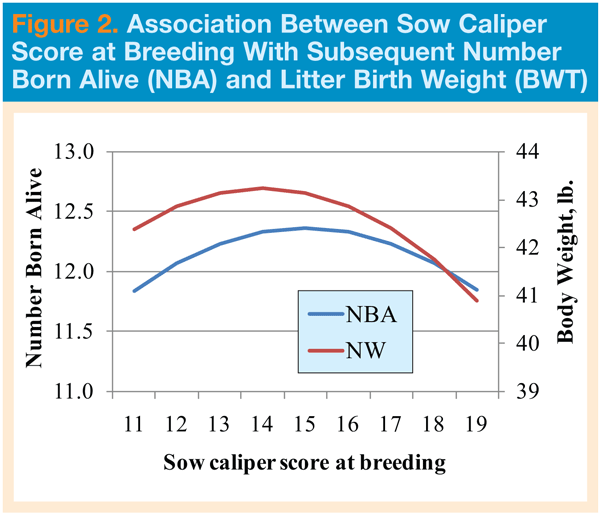
Litter weaning traits also had significant associations with breeding weight, backfat, body condition score and sow caliper score. Weight at breeding had linear relationships with number weaned (See Figure 1), litter weaning weight and wean-to-conception interval. For each 100-lb. decrease in sow weight, number weaned and litter weaning weight increased by 0.35 piglets and 5.3 lb., respectively, and wean-to-conception interval decreased by one day.
Backfat at breeding was correlated with wean-to-conception interval. For each 0.1-in. decrease in backfat, wean-to-conception interval decreased by 0.16 days. Both body condition score and the sow caliper score had curvilinear associations with wean-to-conception interval. The optimal body condition score in relation to wean-to-conception interval was 3, with 14 being the optimal caliper score.
Sow Condition at Farrowing, Subsequent Performance
Litter birth traits had significant correlations with farrowing backfat, loin eye area, body condition score and sow caliper score. Farrowing backfat, loin eye area and the caliper had linear associations with number born alive. A decrease of 0.1 in. backfat, 0.5 in.loin eye area and 1 caliper score increased number born alive by 0.08, 0.13 and 0.15 piglets, respectively. Body condition score and the sow caliper were correlated with litter birth weight. For each decrease in body condition score by 0.5, and sow caliper score by 1, litter birth weight increased by 1.0 and 0.7 lb., respectively.
Litter weaning traits had significant associations with farrowing weight, backfat and body condition score. Farrowing weight and backfat had linear relationships with number weaned. A decrease of 100 lb. in sow weight and 0.1 in. of backfat increased number weaned by 0.19 and 0.03 piglets, respectively.
Both farrowing weight and body condition score had curvilinear associations with litter weaning weight. The optimal farrowing weight and body condition score in relation to litter weaning weight were 525 lb. and a score of 3.75, respectively.
Lactation Feed Intake, Subsequent Performance
Feeding sows to an optimal body condition during gestation prepares them for successful reproduction throughout their lifetime. It is well-documented that sows that are overconditioned when entering lactation will eat less feed in comparison to thinner sows.
High lactation feed intake is needed to support milk production, and is necessary in order for the sow to prepare herself for the next reproductive cycle.
In the current study, a 1-lb. increase in average daily lactation feed intake increased litter weaning weight by 8.6 lb., and subsequent number born alive by 0.32 piglets.
These results suggest sows should be managed to maximize lactation feed intake in order to increase reproductive performance. This approach includes strategically optimizing body condition during gestation to enhance feed intake when the sow needs it most, during lactation.
Considerations for Selecting a Scoring Method
The current NCSU study found optimal breeding targets for sow weight (475 lb.), body condition score (3.0) and caliper score (14 to 15) in relation to subsequent reproductive performance. These results suggest multiple tools may be used to define ideal body condition in relation to reproduction. One should consider the pros and cons of each method before implementation.
Producers should be careful when implementing a visual body condition scoring system. Barn workers not properly trained to evaluate sow condition visually can cost producers significantly, due to excess feed costs and reduced reproductive performance.
Employees must initially be trained to evaluate body condition visually, and periodically be recertified to ensure their ideal for sow condition matches each system’s target. Tools are available to help train employees to evaluate sow body condition visually.
The poster entitled “Scoring Sow Body Condition” that has been included in this Blueprint issue is an educational tool designed to help individuals properly evaluate sow body condition. In addition to the poster, the sow body condition caliper can be used to help train employees to score body condition visually.
Perhaps measuring sow weight on farms is a futuristic approach to monitoring sow body condition. Currently, most commercial sow farms do not have a scale. Producers should consider installing a scale to monitor sow weight as they build or remodel facilities in the coming years.
Weight can currently be monitored quite accurately by measuring a sow’s heart girth. However, the current method of appraising a sow’s heart girth (using a sow tape) can be challenging to implement.
The sow caliper is a new, objective approach to evaluating condition. The sow body condition caliper is a fast and accurate tool. In fact, the sow caliper was used to select the sows for the body condition poster insert in this Blueprint issue.
Implementation of the sow caliper on commercial farms has begun. After initial training with the caliper, sow farm service people should revisit barn workers to validate proper usage of the technology. Some adopters of the sow caliper have discontinued assigning a body condition score and simply marked the caliper with the amount of feed that should be delivered to the sow. The sow body condition caliper does have an initial investment of $200 (contact the article author to buy one). However, producers are using one caliper per farm.
An optimal backfat was not identified in relation to reproductive performance. Perhaps future studies will define the ideal backfat for reproduction. One limitation of measuring backfat is that it is lowly correlated with muscling. It should be noted that measuring backfat is an acceptable method of monitoring herd body condition. Further mining of the current data set is needed to evaluate more complex traits (e.g., percent fat, fat-to-muscle ratio) in relation to reproduction.
Defining ideal sow body condition can help enhance animal well-being and maximize reproductive efficiency. The current research project was an observational study. Further studies consisting of feeding sows to specific body condition targets are needed to validate reported results. For questions on this article, contact Mark Knauer.
Read more sow housing stories:
Group Sow Housing: Practical Considerations
Group Sow Housing Alternatives: Building New vs. Remodeling Existing Facilities
Management to Control Aggression in Group Housing
You May Also Like



